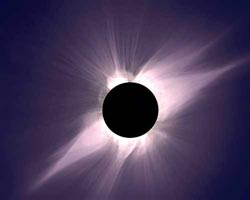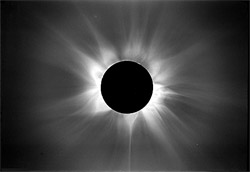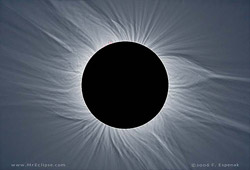August's total solar eclipse will be an exciting prelude to the Summer Olympics!
ISSUE #63: Eclipse

Figure 1 - This 1991 photograph captures the brief moment of totality when the Sunís faint corona is most easily observed. It is made up of several photographs from cameras with different settings that were later combined into one image. Credit: Steve Albers, Dennis di Cicco, ad Gary Emerson.
Total solar eclipses are thrilling to watch. This year's eclipse will occur on August 1, visible in China, followed by one on July 22, 2009 which will be visible from India, across Southeast Asia and Southern Japan.
The next total solar eclipse visible from the United States will be on August 21, 2017!
The most famous eclipse of ancient times ended a five-year war between the Lydians and the Medes who were locked in battle. The sight of the total solar eclipse on May 28, 585 B.C. was startling enough to cause both nations to stop fighting at once.
In ancient China, the solar and lunar eclipses were regarded as heavenly signs that foretell the future of the Emperor. The ancient Chinese believed that solar eclipses occur when a legendary celestial dragon devours the Sun. They also believed that this dragon attacks the Moon during lunar eclipses. In the Chinese language, the term for eclipse was "chih" which also means "to eat". One ancient Chinese solar eclipse record describes a solar eclipse as "the Sun has been eaten". It was a tradition in ancient China to bang drums and pots and make loud noise during eclipses to frighten that dragon away. Even more recently, in the nineteenth century, the Chinese navy fired its cannons during a lunar eclipse to scare the dragon that was eating the Moon. For more on the upcoming eclipse in china, visit the Sun-Earth Day website (URL for our china webpage)

Figure 2: Eclipse 1980 - solar max again (Credit: High Altitude Observatory/ National Center for Atmospheric Research).
The shape of the corona, the most noticible feature of an eclipse other than the absence of the sun from the sky!
The shape of the corona and its brilliance, have a lot to do with the amount of solar activity on the sun. During sunspot maximum, when there are plenty of sunspots and tangled magnetic fields on the solar surface, the corona is very blotchy-looking with prominent streamers and rays shooting high up from the surface and disappearing into space. A total solar eclipse seen during solar maximum years near 2001, 1991, 1980 and 1970 will be very bright and complex in shape as shown in Figure 1 for the total solar eclipse of 1991 and Figure 2 for 1980. During sunspot minimum conditions near the years 2008, 1996, 1986 and 1976, the corona will be weaker in intensity, less structured and cover more of the full disk of the moon. This can be seen, for example, in Figure 3 taken during an eclipse in 2006.
GALLERY
RELATED ECLIPSE LINKS
- Eclipses Through Traditions and Cultures, 1999, http://eclipse99.nasa.gov/pages/traditions_morechina.htm
- The NASA Eclipse Website, 2008, http://eclipse.gsfc.nasa.gov/eclipse.html
- Eclipse: In a Different Light, 2006 - http://sunearthday.nasa.gov/2006/index.php
- The Solar Corona - http://sunearthday.gsfc.nasa.gov/2007/locations/ttt_corona.php
- First Corona Descriptions - http://sunearthday.gsfc.nasa.gov/2006/locations/firstcorona.php
2008 ISSUES
- #63: Eclipse
- #62: Where is the heliopause?
- #61: What causes and Auroral Storm?
- #60: Where does the Sun's magnetic field come from?
- #59: Where did all the Neutrinos go?
- #58: Why is the Sun's Corona Hot?
View past issues
Space Weather Fact
During a single second, the sun converts 4 million tons of matter into pure energy.





